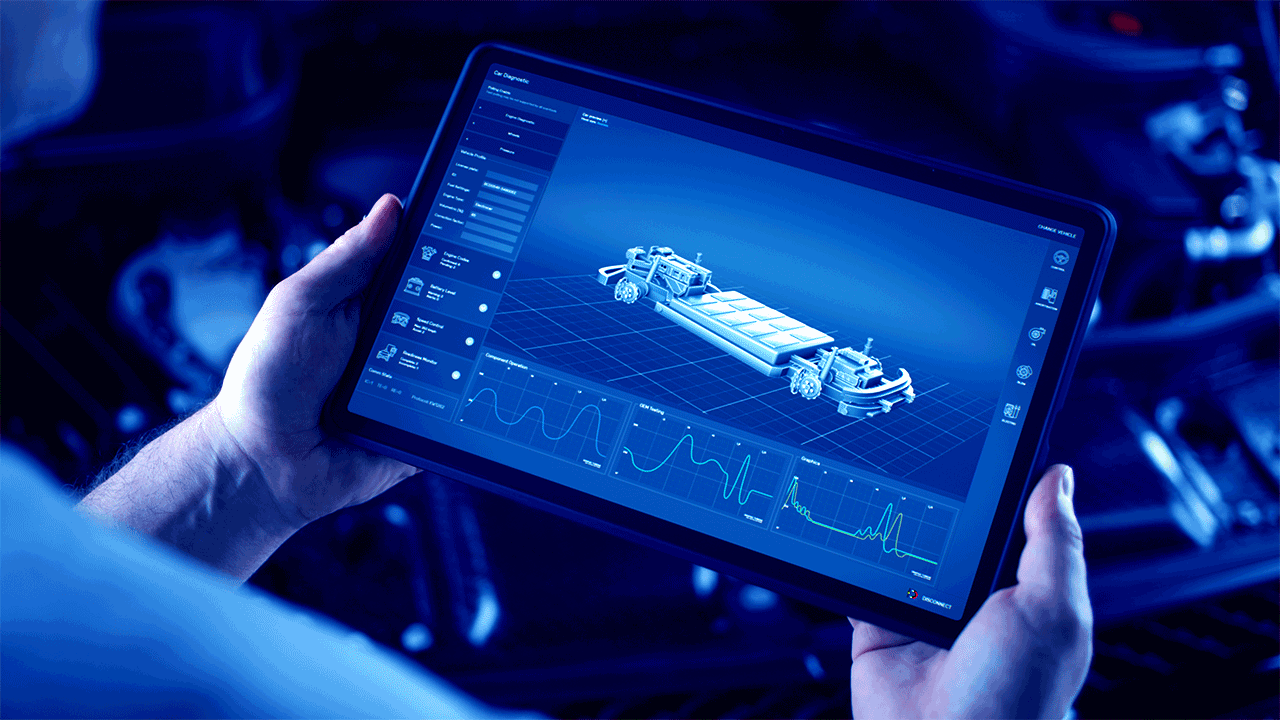Why is Data-driven User Experience important in EV technology
What is the Importance of a Data-driven User Experience in Automotive?
Unlock Engineering Insights: Explore Our Technical Articles Now!
Discover a Wealth of Knowledge – Browse Our eBooks, Whitepapers, and More!
Stay Informed and Inspired – View Our Webinars and Videos Today!
8 min read
 James Roberts
:
May 9, 2022 1:45:25 PM
James Roberts
:
May 9, 2022 1:45:25 PM

The Electric Vehicle (EV) is not new, but it has been receiving significantly more attention in recent years. Advances in both EV analytics and battery technologies have led to increased automotive market share. However, this growth is not attributed to hardware alone. The modern mechatronic vehicle marries electrical storage and propulsion systems with electronic sensors, controls, and actuators. These are integrated closely with software, secure data transfer, and data analysis. All of these elements are validated through rigorous electric vehicle testing, to form a comprehensive transportation solution. Advances in all these areas have contributed to the overall rise of EV’s, but the common thread that runs through all these elements is data analytics.
In this article, we will focus specifically on the data analytics considerations in the EV realm, to examine how these powerful solutions can drive growth and competitive advantage.
It can be said that the development of today’s modern electric vehicle is the story of the development of electrical propulsion shaped and driven by the analysis of data. Electric vehicle technology is much older than many people realize. The first electric cars were invented in the 1830’s, but the technology did not become viable until the storage battery was invented in 1865 and improved upon in 1881. Even in those earliest days, the pioneering inventors were taking notes, making observations, and designing improvements based on the data they were collecting and sharing.
EV’s have been in continuous use in a variety of applications since the 1900’s. Their early rudimentary technology limited their range to around 50 miles and made them susceptible to failure in cold weather. In comparison, internal combustion engine (ICE) technology was not as impacted by these specific limitations, contributing in part to the widespread adoption of ICE-powered vehicles over most of the 20th Century.
As internal combustion came into common use, data about its weaknesses also became known. An ICE emitted noxious fumes, had many complex moving parts, and could be a source of unwanted combustion in explosive environments. So, EV technology continued to be quietly developed and improved upon as both industry and transportation found other unique applications for safe and clean electric propulsion.
For example, electrically driven railroad locomotives of all sizes were utilized in underground environments such as tunnels and mines, where the noxious emissions from combustion made electric propulsion the only safe alternative. It was also used in locations where electricity could be generated economically and distributed efficiently via overhead wires, such as interurban passenger applications, street trolleys, and urban electric buses. These were highly engineered systems that utilized an extensive analysis of data to optimize every aspect of their design, construction, operation, and control, in the most efficient and cost-effective manner.
Later in the century, industry adopted forklifts and self-propelled pallet jacks by the millions that incorporated numerous electric subsystems or, in many instances, all-electric components. These units provided a wealth of valuable data points about using electric propulsion and control technology in harsh real-world industrial environments. This data aided the development of smaller and more powerful and efficient motors and drove improvements to battery systems that gave them greater storage capacity and increased durability and reliability.
Soon, semi-autonomous electrically driven robotic shuttles were shuffling parts along control wires embedded in factory floors, towing trains of part and subassembly carts and providing valuable data about electrical vehicle operation, control logic and programming, communications, sensors, logistics, and autonomy. All these applications required the development of smaller and better electrical motors, the overall advancement of electrical propulsion and control science, and the growth of a skilled worker and engineering force that could apply and expand this knowledge. And in turn, all these advancements fed into the increasing pace of EV development.
All these various applications shared two things in common: 1.) an electric motor driving a wheel or gear to do work, and 2.) the systematic recording and analysis of data to drive continuous improvement, increase value, and reduce costs.
EV’s must transport people safely, and they must carry their power onboard. So, as EV battery technology improved in other applications, EV development benefitted in turn. And, as computers grew in power and capability while shrinking in size and weight, they introduced a practical means of gathering and leveraging critical data about the EV in real time, to improve both safety and performance while making safe control practical. These six primary ingredients ─ electrical storage, propulsion, data, sensors, computational power, and control ─ form the foundation of today’s modern mechatronic electronic vehicles.
By the end of the 20th Century, the various EV technologies had advanced to the point where they could be brought together into one vehicle, and mass production could be economically viable. In the late 1990’s General Motors (GM) released the EV1, the first mass-produced electronic vehicle offered by a major U.S. automaker, and the first designed from the start to be an electric vehicle. The initial customer reaction to the EV1 was positive, but additional development work needed to be done with the technologies, the regulatory environment, liability considerations, and the economic models for a vehicle with greater reliability and fewer moving parts than their internal combustion counterparts. The production line for both the Gen I and II EV1’s was shut down in the late 1990’s, and vehicle leasing ended in 2003. In total, only 1,117 EV1’s were produced. However, the data this program produced was of immense value.
This turn of events did not discourage other automobile manufacturers from entering the electronic vehicle marketplace. The GM EV1’s enjoyed an intensely loyal customer base, a point not lost on GM’s competitors. EV models were eventually produced by all major manufacturers. And 10 years after the demise of the EV1, GM re-entered the market with the Chevy Volt, which itself has since been eclipsed by multiple EV offerings in the GM lineup.
With EV technologies now enjoying continuous improvement, momentum is growing. Additional EV’s have found their way to the marketplace, along with alternative technologies such as hybrid vehicles. Improvements have continued at an ever-increasing pace in both EV technology and supporting technologies such as data processing, computational power, battery technology, and the EV charging and maintenance infrastructure. Business and regulatory conditions have evolved to a more favorable stance. And the amount of data being generated, analyzed, and applied to future work, is staggering. With today’s wholesale participation by many major automobile manufacturers, critical mass for permanence has been achieved and electric vehicles now occupy a space in the marketplace that is only expected to grow.
The consumer has some particularly good reasons to adopt today’s EVs:
Most significantly, manufacturers can now leverage a transformative technology that was not readily available to them in 1999, to make their vehicles more dependable, maintainable, and serviceable: Big Data.
Compared to routine data sets, Big Data is defined as consisting of significantly larger and more complex sets of data, either structured or non-structured, often from new sources. The key word here is “significantly.” These sets of data are notoriously massive and hard to manage. They can be so large, that traditional data transfer systems and processing software practically choke on them. And they are typically growing all the time.
In our LHP blog, “How Does Big Data Impact the Automotive Industry?”, author Bhavana Shah describes Big Data as “…huge amounts of constantly changing data that is difficult to handle but is of enormous value…”. That value drives the efforts and investments required to capture and manage it. If Big Data did not have immense value, no one would bother with the headaches it can bring.
That value is extracted through macro-tools created to identify patterns in the chaos. Once the patterns are identified and analyzed, smart solutions can be developed based upon what the data are telling you. Machine learning, predictive modeling, and other advanced applications can be built to manage the large volume of data, the wide variety, and the velocity at which the data is generated, gathered, and processed.
Predictive analysis is one of the most important forms of big data analytics. It helps to predetermine the characteristics and behavior of a machine, system, or other entity. If the only data available were reactive and historical in nature, the industry would forever be playing catch-up, with no clue as to which way to turn next. With predictive analysis, the EV and its supporting systems can analyze driver and passenger behavior and improve itself to better meet the needs of the humans.
Predictive analytics is key to driving EV infrastructure growth. An EV car can generate terabytes of data in an eight-hour drive. Within that chaotic data are answers to questions that have not yet been asked. Identify the patterns, and you can identify the most valuable questions to ask. Ask valuable questions, and you can get valuable answers that people are willing to pay for.
For example, the potential for monetizing connected car data is massive. EV’s require a network of chargers out in the world to recharge their batteries enroute. Those charger networks are expensive to install, and the investment can only be recouped with a certain threshold of use. Revenue can also be generated if the charger is located near a complimentary business such as a convenience store, restaurant, or dealership maintenance facility. However, competitors can also install their own charger networks, drawing away customers and increasing the risk of EV damage due to charger incompatibilities or inferior chargers. Or worse, they can steal away customers by steering their brand loyalty to a competing brand of EV.
Big data can help retain a customer within their own charger network by anticipating the remaining distance left in a battery until a recharge is required, placing charger information and directions onto the EV’s GPS navigation system, automatically reserving chargers before arrival, and analyzing charger states to prevent sending a customer to an inoperative charger and stranding them there. Big data can assess the condition of the vehicle and make recommendations on maintenance intervals and dealer locations, timing maintenance to coincide with a charging interval thus allowing the driver to accomplish two tasks simultaneously. Software updates can be pushed out to the vehicle while charging, enabling a much faster data connection than wireless. It can also access data about the shopping trends and preferences of the humans onboard, flashing ads and discounts to the driver and passengers if the charger is close to a complimentary business. And suggestions for lodging can be displayed if a driver begins to exhibit signs of fatigue. All these synergies, and many more, are possible by leveraging big data and predictive analytics.
In today’s modern automotive realm, the data scientist stands shoulder-to-shoulder with the other engineers, technicians, and skilled professions, that all work together to bring today’s EV’s and their associated systems to life. It is a highly technical skill path that is both rewarding, and in great demand. And for the incurably curious, it can be deeply rewarding.
From those early days of the first pioneering vehicles, the automotive industry has steadily evolved from just reactive data gathering and analysis, to embracing the entire data science realm. Today, in addition to the more traditional skills of computer programming, data mining, and analyzing large volumes of data, modern data scientists, analysts, and engineers, must also be proficient across the entirety of the data science lifecycle. They must possess the mental agility and flexibility to comprehend, understand, and maximize the returns found in each phase.
The Data Science Lifecycle is a continuous loop process that is defined in five stages:
Every step in this lifecycle directly relates to the design and safe operation of an EV, and the infrastructure that supports it. The steps must be performed properly, and in the proper order. The data must be accurate and complete. There is no room for shortcuts.
Data is to an EV as blood is to a living organism. It is continuously on the move, being generated, flowing from system to system, being analyzed, and being leveraged to perform useful work. This analogy is true for both the vehicle, and the supporting power grid system. And in the future, as autonomous vehicles are introduced to the market, the volume and flow of data will grow exponentially as it is extended to other vehicles and the surrounding environment.
This modern comprehensive approach to managing and processing data provides a better user experience, significantly increases the serviceability and quality of the EV and its operation and ownership, and delivers overall value, all via big data. This is a key discriminator for the next generation of EVs and autonomous vehicles. And, frankly, it is the only practical means by which a functionally safe ecosystem for EV’s and autonomous vehicles will be able to exist.
In the next article in this series, we examine the importance of a data-driven user experience, as well as considerations around charging optimization, reliability, serviceability, maintainability, cost reductions, and the overall value that data analytics provides to the EV manufacturer.
Why is Data-driven User Experience important in EV Technology

What is the Importance of a Data-driven User Experience in Automotive?

{% video_player "embed_player" overrideable=False, type='hsvideo2', hide_playlist=True, viral_sharing=False, embed_button=False, autoplay=False,...

{% video_player "embed_player" overrideable=False, type='hsvideo2', hide_playlist=True, viral_sharing=False, embed_button=False, autoplay=False,...